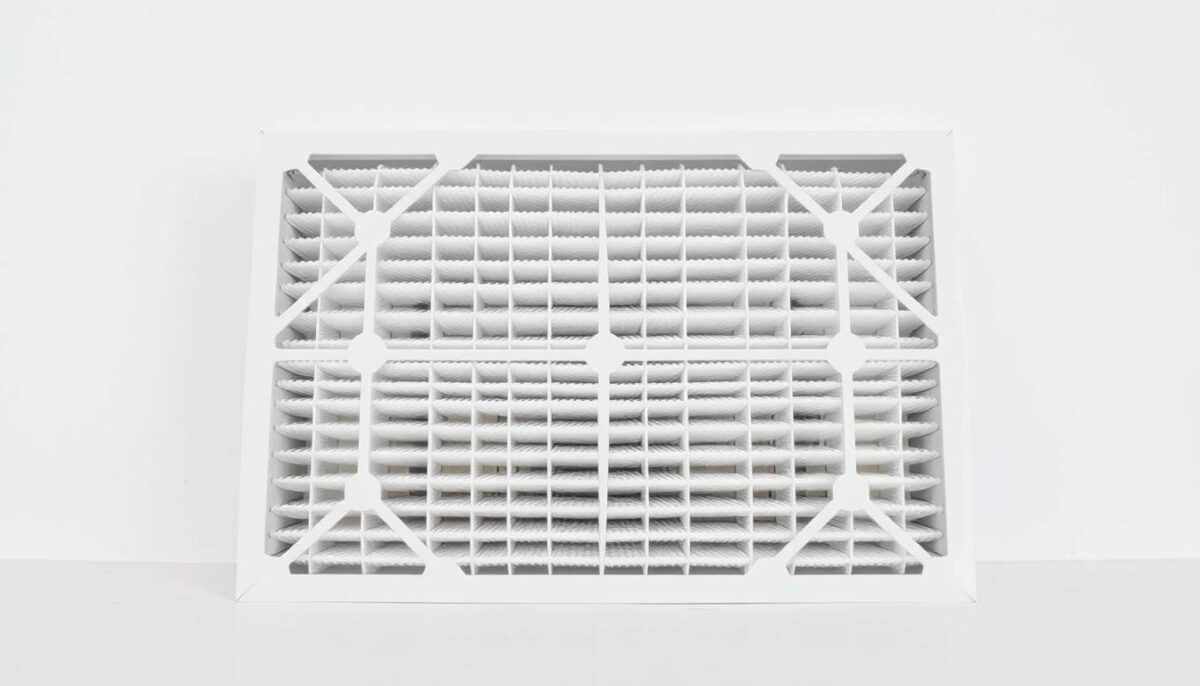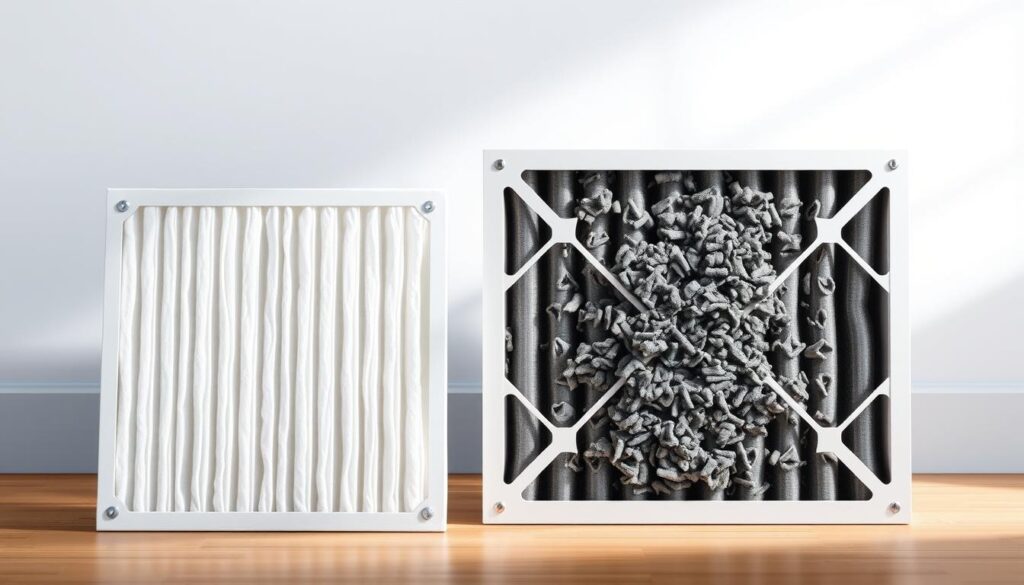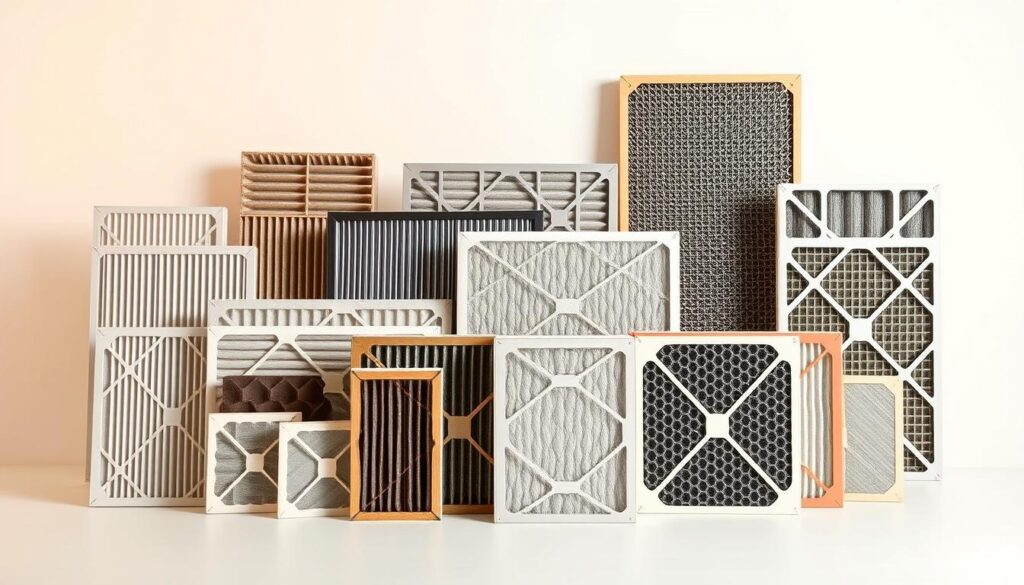HVAC Filter Replacement: How Often Should You Change It?

Maintaining a healthy indoor environment is crucial for the well-being of your family, and a key aspect of this is ensuring your heating and cooling system operates efficiently.
A critical but often overlooked part of home maintenance is the regular replacement of air filters. This simple task directly impacts your system’s performance and the air quality in your home.
Dirty or clogged air filters can lead to increased energy bills and potentially costly repairs down the line. On the other hand, clean filters improve indoor air quality by trapping dust, allergens, and other airborne particles.
Understanding when and how to replace your HVAC filters is essential. The frequency of replacement depends on various factors, including the type of filter used and household conditions.
Key Takeaways
- Regular air filter replacement improves indoor air quality.
- Dirty filters can increase energy bills and lead to costly repairs.
- The frequency of replacement depends on filter type and household conditions.
- Clean filters are essential for the efficient operation of your heating and cooling system.
- Proper maintenance can lead to substantial energy savings.
The Importance of Regular HVAC Filter Replacement

The significance of regularly replacing your HVAC filter cannot be overstated, as it directly impacts your system’s performance and indoor air quality. A dirty or clogged filter forces your system to work harder, increasing energy consumption and potentially leading to premature system failure. For more detailed information on the importance of regular HVAC filter replacement.
How Filters Impact Your HVAC System Performance
A clean HVAC filter is essential for optimal system performance. When filters are dirty or clogged, they restrict airflow, causing your system to consume more energy while delivering less comfort. This not only increases your utility bills but also puts unnecessary strain on vital system components.
Clean filters, on the other hand, allow for proper airflow, ensuring consistent temperature control throughout your home. Regular filter maintenance helps prevent dust and debris buildup on sensitive components like the evaporator coil, which can cause system inefficiency or failure.
Effects on Indoor Air Quality and Health
Your HVAC filter serves as the first line of defense against airborne contaminants, trapping dust, pollen, pet dander, and other particles that would otherwise circulate through your home. For households with allergy or asthma sufferers, regular filter replacement is especially important as it significantly reduces respiratory triggers in the indoor environment.
Studies have shown that indoor air can be 2-5 times more polluted than outdoor air, making proper filtration an essential aspect of maintaining a healthy home environment. By regularly replacing your HVAC filter, you can significantly improve indoor air quality and reduce the risk of respiratory issues.
The efficiency of an HVAC filter is indicated by its Minimum Efficiency Reporting Value (MERV). Here’s a breakdown of MERV ratings and their corresponding efficiencies:
| MERV Rating | Efficiency Description |
|---|---|
| 1-4 | Minimal filtration, captures large particles |
| 5-11 | Moderate filtration, captures smaller particles including dust and pollen |
| 13-14 | High-efficiency filtration, captures very small particles including bacteria and viruses |
Understanding Different Types of HVAC Filters

HVAC filters come in a variety of types, each with its unique characteristics and benefits. Choosing the right filter for your heating, ventilation, and air conditioning (HVAC) system is crucial for maintaining good indoor air quality and ensuring the efficiency of your system.
The main types of HVAC filters are designed to cater to different needs and preferences. Understanding these differences is key to making an informed decision.
Fiberglass Filters
Fiberglass filters are the most basic and affordable option. They consist of layered fiberglass fibers that provide minimal filtration. Due to their limited particle-trapping capacity, they need to be replaced monthly.
Pleated Filters
Pleated filters offer improved filtration through an accordion-style design that increases their surface area. This design allows them to capture more particles while maintaining good airflow, making them a good option for up to three months.
HEPA Filters
HEPA (High-Efficiency Particulate Air) filters provide superior filtration by capturing 99.97% of particles as small as 0.3 microns. They are ideal for households with allergy sufferers or respiratory conditions.
Washable/Reusable Filters
Washable or reusable filters offer an environmentally friendly alternative. They can be cleaned and reused for up to five years, although they typically provide moderate filtration compared to disposable options.
MERV Ratings Explained
Understanding MERV (Minimum Efficiency Reporting Value) ratings is crucial when selecting a filter. MERV ratings range from 1-20, with higher numbers indicating better filtration. Most residential HVAC systems work best with filters in the 8-13 MERV range, balancing effective filtration with proper system airflow and energy efficiency.
Each filter type offers different benefits: fiberglass filters are budget-friendly but less effective, pleated filters balance cost and performance, HEPA filters provide maximum filtration, and washable filters reduce waste. The right filter choice depends on your specific needs, such as households with pets, allergy sufferers, or those in high-pollution areas, who may benefit from higher-rated filters despite the increased cost.
HVAC Filter Replacement Guide: Determining the Right Schedule
Determining the ideal HVAC filter replacement schedule is crucial for maintaining your system’s efficiency and indoor air quality. The frequency of replacement can vary based on several factors, including the type of filter, household conditions, and environmental factors.
Standard Replacement Timeframes
The type of HVAC filter you use plays a significant role in determining how often it should be replaced. Basic fiberglass filters typically need to be changed every month due to their lower MERV ratings and less efficient filtration capabilities. On the other hand, pleated filters, which have higher MERV ratings and can capture smaller particles, can last up to three months under normal conditions.
| Filter Type | Standard Replacement Interval |
|---|---|
| Fiberglass Filters | Every 1 month |
| Pleated Filters | Every 3 months |
| HEPA Filters | Every 6-12 months |
Factors That Affect Replacement Frequency
Several factors can influence how often you should replace your HVAC filter. Understanding these can help you tailor a replacement schedule to your specific needs.
Pets in the Home
If you have pets, especially those that shed heavily, you’ll need to replace your filters more frequently—typically every 30-45 days. Pet hair and dander can quickly accumulate in the filter, reducing its effectiveness and potentially exacerbating allergies.
Allergies and Respiratory Conditions
For households with allergy sufferers or individuals with respiratory conditions, more frequent filter changes (every 30 days) and using higher MERV-rated filters can significantly improve indoor air quality.
Home Size and Location
The size of your home and its location can also impact replacement frequency. Larger homes circulate more air through filters, while homes in dusty areas or near construction sites may require more frequent changes due to increased particulate matter in the air.
Seasonal Considerations for Filter Changes
Seasonal variations can affect how hard your HVAC system works, thereby influencing filter replacement needs. During peak usage periods (summer and winter), filters may need to be replaced more frequently. Additionally, during high pollen seasons or when wildfire smoke affects your area, consider checking filters every 2-3 weeks and replacing them as needed.
Creating a filter replacement calendar or setting reminders can help maintain a consistent schedule, ensuring your HVAC system operates efficiently year-round. It’s also worth noting that the cost of more frequent filter replacements is significantly less than the potential expense of HVAC repairs caused by restricted airflow and system strain from dirty filters.
Step-by-Step Guide to Replacing Your HVAC Filter
Replacing your HVAC filter is a straightforward process that can significantly impact your system’s efficiency and indoor air quality. Regular maintenance ensures that your system runs smoothly and effectively, providing a healthier indoor environment.
Locating Your Air Filter
The first step in replacing your air filter is to locate it. Typically, you can find the filter in the return air vent, often situated on walls or ceilings, or inside the HVAC unit itself. It might also be housed in a dedicated filter housing along the return ductwork. If you’re having trouble finding it, check your HVAC unit, usually located in a basement, crawlspace, closet, or attic.
Selecting the Correct Replacement Filter
Before purchasing a replacement filter, it’s essential to check the size of your current one. The size is usually printed on the filter frame; common sizes include 16×20, 20×25, and 14×25 inches. If the size isn’t indicated, measure the length, width, and thickness of the filter. Additionally, consider the MERV rating appropriate for your system to avoid restricting airflow.
Proper Installation Process
To install the new filter correctly, first, ensure your HVAC system is turned off to prevent dust from being pulled into the system and to avoid electrical hazards. Then, carefully remove the old filter and note the airflow direction arrows on its frame.
Understanding Airflow Direction
The airflow direction arrows on the filter should point towards the ductwork or the blower unit when installed. Inserting the new filter with the arrows pointing in the same direction as the old one ensures proper installation. Make sure the filter fits snugly into its housing without being forced or bent.
As John Doe, an HVAC expert, notes, “Proper filter installation is crucial for the efficiency and longevity of your HVAC system. It’s not just about replacing the filter; it’s about doing it correctly to maintain good air quality and system performance.”
| Installation Step | Description |
|---|---|
| 1. Turn off the HVAC system | Prevent dust from being pulled in and avoid electrical hazards |
| 2. Remove the old filter | Note the airflow direction arrows for correct new filter installation |
| 3. Install the new filter | Ensure arrows point towards the duct work or blower unit |
Disposing of Old Filters
When removing the old filter, consider placing it directly into a plastic bag to prevent captured dust and allergens from being released back into your home. This simple step helps maintain indoor air quality during the replacement process.
By following these steps and setting a reminder for your next filter change based on the manufacturer’s recommendations and your household’s specific needs, you can maintain consistent air quality and system performance.
Signs Your HVAC Filter Needs Immediate Replacement
A clogged HVAC filter can significantly impact your system’s performance and your home’s indoor air quality. When your filters get clogged up with dust and debris, they really put a damper on airflow, making your HVAC system work inefficiently and sometimes leading to equipment problems.
Visual Indicators of a Dirty Filter
Visual inspection is a straightforward way to determine if your filter needs replacement. A filter that appears gray or black instead of its original white or light color is collecting dust effectively but may be approaching capacity. When you can no longer see the filter material through the accumulated dust and debris, it’s time for a replacement.
System Performance Warning Signs
Reduced airflow from vents throughout your home is a clear indicator of a clogged filter. Unusual or extended system cycling and higher than normal energy bills without corresponding weather changes can also signal that your HVAC system is working inefficiently due to a clogged filter.
| Performance Issue | Cause | Effect |
|---|---|---|
| Reduced Airflow | Clogged Filter | Less Comfort |
| Extended System Cycling | Restricted Airflow | Increased Energy Consumption |
| Higher Energy Bills | Inefficient System Operation | Increased Costs |
Air Quality and Health Indicators
The appearance of dust on vents and registers or increased dust accumulation on surfaces throughout your home suggests that your filter is no longer effectively capturing particles. Allergy symptoms or respiratory issues that worsen when the HVAC system is running may indicate that your filter is saturated and allowing allergens to circulate through your home.
By being aware of these signs, you can determine when your HVAC filter needs immediate replacement, ensuring your system runs efficiently and your home’s air quality remains high.
Benefits of Maintaining a Regular Filter Replacement Schedule
The benefits of sticking to a regular HVAC filter replacement schedule are multifaceted, ranging from improved energy efficiency to better indoor air quality. By changing your filter regularly, you can ensure your HVAC system operates at its best, providing a comfortable and healthy indoor environment.
Energy Efficiency and Cost Savings
Regular filter replacement can significantly improve your HVAC system’s energy efficiency. Clean filters allow air to flow freely, reducing the system’s workload and energy consumption. Studies have shown that regular filter changes can reduce energy consumption by up to 15%. This not only lowers your utility bills but also contributes to a more sustainable environment. For the average household, this can translate to potential annual savings of $100-$200.
| Filter Condition | Energy Consumption | Annual Savings |
|---|---|---|
| Clean Filter | Normal | $100-$200 |
| Dirty Filter | High | $0 |
Extended HVAC System Lifespan
Maintaining a clean filter is crucial for extending the lifespan of your HVAC system. When filters are clogged, dust and debris accumulate on sensitive components, causing strain and wear. Regular filter replacement prevents this buildup, helping to avoid costly repairs and prolonging the system’s life. By investing in routine filter changes, you’re protecting your significant home investment.
“A well-maintained HVAC system is key to a comfortable and healthy home. Regular filter replacement is a simple yet effective maintenance task.”
Improved Indoor Air Quality
Regular filter changes significantly improve indoor air quality by reducing airborne particles. This is particularly beneficial for households with children, elderly members, or individuals with allergies. Studies indicate that proper filtration can reduce indoor airborne particles by up to 50%, creating a healthier living environment. By maintaining clean filters, you’re ensuring the air in your home is clean and safe to breathe.
Smart Strategies for HVAC Filter Maintenance
Effective HVAC filter maintenance is a simple yet vital task that impacts both your system’s performance and indoor air quality. To simplify this process, consider implementing a few smart strategies.
Start by creating a digital calendar reminder system to alert you when it’s time to check or replace your HVAC filter. You can also subscribe to filter delivery services that automatically ship replacement air filters to your home based on your preferred schedule.
Other helpful tips include keeping a maintenance log near your HVAC unit, storing replacement filters in a clean, dry location, and using the plastic packaging from the new filter as a disposal bag for the old one to contain dust and debris. By following these guidelines, you can ensure your home air remains clean and your HVAC system runs efficiently.
For optimal protection, consider using higher MERV-rated filters during high pollen seasons or pollution events. By maintaining a regular filter replacement schedule, you’ll be able to enjoy clean air and a well-functioning HVAC system.



